| |
|
|
||
| |
|
|
||
| |
| Latino Music ¡Mi Musica: Colombia, Panamá, and México! |
Further waves of immigration occurred during and after both World Wars and, most significantly, in the late 1980s and 90s. At that time immigrants from México as well as Central America and South America came to Iowa, often via California and Texas, to work in packing plants and the businesses that grew to serve a burgeoning Latino community. The demographics of small towns and
Text by Riki Saltzman. Photos by Riki Saltzman, Will Thomson, and Karen Heege. Photos of Calle Sur, Latino instruments, and panpipes courtesy of Calle Sur. Photo of Los Llaneros courtesy of Los Llaneros.
|
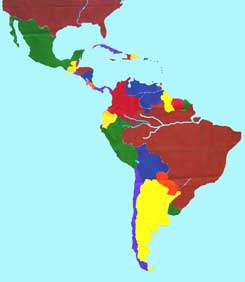

 medical practices.
medical practices. 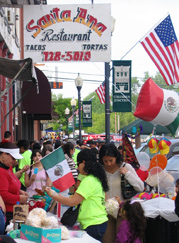
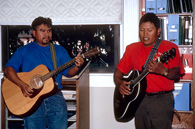 clothing stores, churches, and community centers have contributed to the diversity in Iowa. Community festivals around the state
provide a way for Latinos and Anglos alike to enjoy a variety of traditional music, food, dance, and more.
clothing stores, churches, and community centers have contributed to the diversity in Iowa. Community festivals around the state
provide a way for Latinos and Anglos alike to enjoy a variety of traditional music, food, dance, and more. 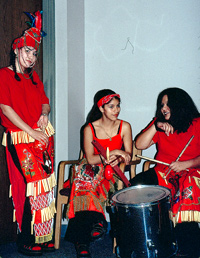 Like other aspects of culture, the musical traditions of Latin America are derived from a variety of cultures. From polkas to waltzes, salsa to calypso, Latino music is about rhythm and harmony, drums and strings, identity and heritage. The African roots of Latino music are apparent in the syncopated rhythms, which emphasize the offbeat. Guitars, violins, and harps recall Spanish and Portuguese ancestors, while the lively polka beat and strains of accordions pay homage to Germans, Poles, and Czechs.
Indigenous sounds and tunes emerge from panpipes, flutes, rattles, and marimbas.
Like other aspects of culture, the musical traditions of Latin America are derived from a variety of cultures. From polkas to waltzes, salsa to calypso, Latino music is about rhythm and harmony, drums and strings, identity and heritage. The African roots of Latino music are apparent in the syncopated rhythms, which emphasize the offbeat. Guitars, violins, and harps recall Spanish and Portuguese ancestors, while the lively polka beat and strains of accordions pay homage to Germans, Poles, and Czechs.
Indigenous sounds and tunes emerge from panpipes, flutes, rattles, and marimbas. 

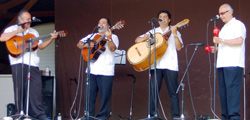
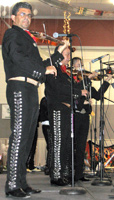 lay mariachi, banda, big band, Tex-Mex, and trio style music. Mariachi bands, such as Mariachi
Los Charros de Jalisco of Sioux City, include trumpets and violins as well as guitars and vocalists. Romantic trios or quartets
like Las Guitarras de México of Des Moines feature requinto, guitarrón, guitarra, and rhythm instruments playing and singing
boleros, cumbias, rancheras, corridos, huapangos, and jarochos. Banda music appeals to a younger audience and features the
sound of marching bands. Tex-Mex groups such as Norberto y los Muchachos of Muscatine feature accordions and play the music of
northern México and southern Texas.
lay mariachi, banda, big band, Tex-Mex, and trio style music. Mariachi bands, such as Mariachi
Los Charros de Jalisco of Sioux City, include trumpets and violins as well as guitars and vocalists. Romantic trios or quartets
like Las Guitarras de México of Des Moines feature requinto, guitarrón, guitarra, and rhythm instruments playing and singing
boleros, cumbias, rancheras, corridos, huapangos, and jarochos. Banda music appeals to a younger audience and features the
sound of marching bands. Tex-Mex groups such as Norberto y los Muchachos of Muscatine feature accordions and play the music of
northern México and southern Texas. 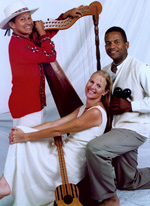 Colombian music includes the now-well known sounds of the Andes Mountains, the panpipes common to the highlands of neighboring countries as well as the llanero (plains) music of the cowboys and the arpa, also shared with Venezuela. The African-influenced cumbia from the Caribbean coast of Colombia is perhaps the country's best known musical export, while the vallenato or valleys of eastern Colombia feature the accordion. Los Llaneros play a variety of Colombian traditional music, as do Ed East (Waterloo) and Karin Stein (Kellogg) of Calle Sur.
Colombian music includes the now-well known sounds of the Andes Mountains, the panpipes common to the highlands of neighboring countries as well as the llanero (plains) music of the cowboys and the arpa, also shared with Venezuela. The African-influenced cumbia from the Caribbean coast of Colombia is perhaps the country's best known musical export, while the vallenato or valleys of eastern Colombia feature the accordion. Los Llaneros play a variety of Colombian traditional music, as do Ed East (Waterloo) and Karin Stein (Kellogg) of Calle Sur.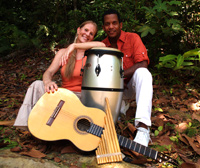 The traditional sounds of Panamá unite folk poetry with popular dance music among a people whose heritage combines mestizo (Spanish and Indian) or a mixture of Spanish, Indian, Chinese, and West Indian traditions. Salsa, merengue, and reggae are all produced in Panama. Most typical of Panama are the Afro-Caribbean rhythms of the pujador and repicador (upright hand drums) along with the smaller, higher-pitched cajas (stick-played drums)), exemplified by the music of Ed East.
The traditional sounds of Panamá unite folk poetry with popular dance music among a people whose heritage combines mestizo (Spanish and Indian) or a mixture of Spanish, Indian, Chinese, and West Indian traditions. Salsa, merengue, and reggae are all produced in Panama. Most typical of Panama are the Afro-Caribbean rhythms of the pujador and repicador (upright hand drums) along with the smaller, higher-pitched cajas (stick-played drums)), exemplified by the music of Ed East.